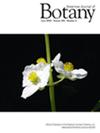Functional trait responses of invasive Ludwigia species to contrasting hydrological conditions
Abstract
Premise
Hydrological regime influences wetland plant species distribution and performance. Global warming and extreme weather events are magnifying flooding patterns, and understanding how invasive taxa respond across life stages (establishment vs. established phase) is important for predicting and managing their colonization and spread. Our objective was to measure flood trait responses at contrasting life stages in closely related congeners (Ludwigia peploides, diploid; L. hexapetala, decaploid; Onagraceae) differing in their invasiveness in the field.
Methods
In the field, we assessed phenological responses to seasonal hydrological changes, and in mesocosms, we assessed flood stress responses of establishing shoot fragments under deep-flooded, shallow-flooded, and gradual drawdown hydrological treatments.
Results
Counter to expectations, establishing L. peploides expressed more flood tolerance traits in mesocosms than L. hexapetala. For example, L. peploides had greater total leaf area and aerenchyma production than L. hexapetala, supporting its growth under flooding, whereas L. hexapetala expressed more flood escape traits (higher shoot elongation rates, trend for longer shoot internode length). Although L. hexapetala expressed some traits associated with drought tolerance, these trends were not significant. In the field, longer-established plants had a reversed pattern for flood escape versus tolerance traits. Ludwigia peploides rapidly shifted to sexual reproduction as soils began to dry, whereas L. hexaetala flowered regardless of soil moisture availability.
Conclusions
These contrasting patterns of flood tolerance versus escape traits demonstrate that invasive Ludwigia congeners have differing strategies to counter physiological stress induced by flooding and emphasize the importance of life stage in response to environmental variation.




 求助内容:
求助内容: 应助结果提醒方式:
应助结果提醒方式:


